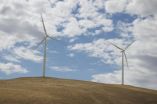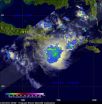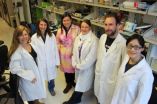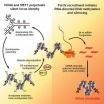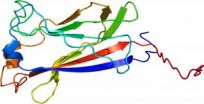(Press-News.org) The worldwide demand for solar and wind power continues to skyrocket. Since 2009, global solar photovoltaic installations have increased about 40 percent a year on average, and the installed capacity of wind turbines has doubled.
The dramatic growth of the wind and solar industries has led utilities to begin testing large-scale technologies capable of storing surplus clean electricity and delivering it on demand when sunlight and wind are in short supply.
Now a team of Stanford researchers has looked at the "energetic cost" of manufacturing batteries and other storage technologies for the electrical grid. At issue is whether renewable energy supplies, such as wind power and solar photovoltaics, produce enough energy to fuel both their own growth and the growth of the necessary energy storage industry.
"Whenever you build a new technology, you have to invest a large amount of energy up front," said Michael Dale, a research associate at Stanford. "Studies show that wind turbines and solar photovoltaic installations now produce more energy than they consume. The question is, how much additional grid-scale storage can the wind and solar industries afford and still remain net energy providers to the electrical grid?"
Writing in the March 19 online edition of the journal Energy & Environmental Science, Dale and his Stanford colleagues found that, from an energetic perspective, the wind industry can easily afford lots of storage, enough to provide more than three days of uninterrupted power. However, the study also revealed that the solar industry can afford only about 24 hours of energy storage. That's because it takes more energy to manufacture solar panels than wind turbines.
"We looked at the additional burden that would be placed on the solar and wind industries by concurrently building out batteries and other storage technologies," said Dale, the lead author of the study. "Our analysis shows that today's wind industry, even with a large amount of grid-scale storage, is energetically sustainable. We found that the solar industry can also achieve sustainable storage capacity by reducing the amount of energy that goes into making solar photovoltaics."
Reducing energy inputs to battery manufacturing is also needed, he said.
Favorable winds
Over the years, consumers have learned to expect electricity on demand from power plants that run on coal, natural gas or oil. But these fossil fuels, which provide reliable, around-the-clock energy, also emit megatons of greenhouse gas that contribute to global warming.
Wind and solar farms provide emissions-free energy, but only generate electricity when the wind blows or the sun shines. Surplus energy can be stored for later use, but today's electrical grid has little storage capacity, so other measures are used to balance electricity supply and demand.
In the study, the Stanford team considered a variety of storage technologies for the grid, including batteries and geologic systems, such as pumped hydroelectric storage. For the wind industry, the findings were very favorable.
"Wind technologies generate far more energy than they consume," Dale said. "Our study showed that wind actually produces enough surplus electricity to support up to 72 hours of either battery or geologic storage. This suggests that the industry could deploy enough storage to cope with three-day lulls in wind, common to many weather systems, and still provide net electricity to society."
The results were especially good for onshore wind turbines. "We found that onshore wind backed by three days of geologic storage can support annual growth rates of 100 percent – in other words, double in size each year – and still maintain an energy surplus," he said.
"These results are very encouraging," said study co-author Sally Benson, a professor of energy resources engineering and director of the Global Climate and Energy Project (GCEP) at Stanford. "They show that you could create a sustainable energy system that grows and maintains itself by combining wind and storage together. This depends on the growth rate of the industry, because the faster you grow, the more energy you need to build new turbines and batteries."
Solar industry
For the solar industry, the Stanford team found that more work is needed to make grid-scale storage energetically sustainable. The study revealed that some solar technologies, such as single-crystal silicon cells, are growing so fast that they are net energy sinks – that is, they consume more power than they give back to the electrical grid. From an energetic standpoint, these industries "cannot support any level of storage," the study concluded.
"Our analysis showed that, from an energetic perspective, most photovoltaic technologies can only afford up to 24 hours of storage with an equal mix of battery and pumped hydropower," Dale said. "This suggests that solar photovoltaic systems could be deployed with enough storage to supply electricity at night, and the industry could still operate at a net energy surplus."
One advantage of wind over solar power is that it has an enormous energy return on investment, Benson explained. "Within a few months, a wind turbine generates enough electricity to pay back all of the energy it took to build it," she said. "But some photovoltaics have an energy payback time of almost two years. To sustainably support grid-scale storage will require continued reductions in the amount of fossil fuel used to manufacture photovoltaic cells."
Other costs
The Stanford team's primary focus was on the energetic cost of deploying storage on wind and solar farms. The researchers did not calculate how much energy would be required to build and replace grid-scale batteries every few years, nor did they consider the financial cost of building and installing large storage systems on the grid.
"People often ask, is storage a good or bad solution for intermittent renewable energy?" Benson said. "That question turns out to be way too simplistic. It's neither good nor bad. Although grid-scale storage of wind power might not be cost effective compared to buying power from the grid, it is energetically affordable, even with the wind industry growing at a double-digit pace.
"The solar industry needs to continue to reduce the amount of energy it needs to build photovoltaic modules before it can afford as much storage as wind can today."
INFORMATION:
The study was co-authored by Charles Barnhart, a postdoctoral scholar at GCEP. Funding for the research was provided by GCEP.
Wind farms can provide society a surplus of reliable clean energy, Stanford study finds
2014-03-20
ELSE PRESS RELEASES FROM THIS DATE:
Satellite confirms Tropical Cyclone Mike's quick disappearing act
2014-03-20
Tropical Cyclone Mike didn't even last a day in the Southern Pacific Ocean as NOAA's GOES-West satellite revealed the storm dissipating just 24 hours after it was born.
The Joint Typhoon Warning Center's second update on Tropical Cyclone Mike was its last. At 2100 UTC/5 p.m. EDT Mike was located near 24.3 south latitude and 157.9 west, about 618 nautical miles/711.1 miles/ 1,145 km southwest of Papeete, Tahiti. Maximum sustained winds were near 35 knots/40 mph/62 kph at that time.
All warnings for the Southern Cook Islands were cancelled and Mike was quickly weakening ...
Face it: Instagram pictures with faces are more popular
2014-03-20
Like them or not, there's more proof that selfies aren't going away any time soon. Georgia Institute of Technology and Yahoo Labs researchers looked at 1.1 million photos on Instagram and found that pictures with human faces are 38 percent more likely to receive likes than photos with no faces. They're also 32 percent more likely to attract comments. The study is one of the first to examine how photos with faces drive engagement on large-scale, image-sharing communities.
The researchers also found that the number of faces in the photo, their age or gender didn't make ...
NASA sees ex-Tropical Cyclone Gillian's remnants persist
2014-03-20
NASA's TRMM satellite continues to follow the remnants of former Tropical Cyclone Gillian as it moved from the Southern Pacific Ocean into the Southern Indian Ocean where it appears to be re-organizing.
The persistent remnants of tropical cyclone Gillian have moved westward over 2,700 km/1,674 miles since forming in the Gulf of Carpentaria on March 8, 2014.
Gillian's coherent remnants were located just to the southeast of the Indonesian island of Java when the Tropical Rainfall Measuring Mission or TRMM satellite flew overhead on March 20, 2014 at 0415 UTC/12:15 a.m. ...
Interpreting neuroimages: The technology and its limits
2014-03-20
Neuroimages play a growing role in biomedical research, medicine, and courtrooms, as well as in shaping our understanding of what it means to be human. But how helpful are they at answering complex questions such as: What is depression? Is a defendant lying? Do we have free will?
These are among the topics explored in Interpreting Neuroimages: An Introduction to the Technology and Its Limits, a special report of the Hastings Center Report. It is edited by Josephine Johnston, a research scholar and director of research, and Erik Parens, a senior research scholar, and ...
Proteins that control energy use necessary to form stem cells
2014-03-20
Proteins that regulate energy metabolism are essential for stem cell formation, University of Washington researchers find.
Two proteins that control how cells metabolize glucose play a key role in the formation of human stem cells, UW researchers report.
The findings advance scientists' understanding of stem cell development but also suggest that the proteins, which also play a role in the process that transforms normal cells into cancer stem cells, might also be targets for new cancer therapies, the researchers write.
The findings appear online in the journal Cell ...
Gene silencing instructions acquired through 'molecular memory' tags on chromatin
2014-03-20
BLOOMINGTON, Ind. -- Scientists at Indiana University have unlocked one of the mysteries of modern genetics: how acquired traits can be passed between generations in a process called epigenetic inheritance. The new work finds that cells don't know to silence some genes based on information hardwired into their DNA sequences, but recognize heritable chemical marks that are added to the genes. These chemical tags serve as a form of molecular memory, allowing cells to recognize the genes and remember to silence them again in each new generation.
The discovery made by a 12-member ...
Study reveals a major mechanism driving kidney cancer progression
2014-03-20
The shortage of oxygen, or hypoxia, created when rapidly multiplying kidney cancer cells outgrow their local blood supply can accelerate tumor growth by causing a nuclear protein called SPOP—which normally suppresses tumor growth—to move out of the nucleus to the cytoplasm, where it has the opposite effect, promoting rapid proliferation.
In the March 20, 2014, issue of the journal Cancer Cell, researchers from Chicago and Beijing describe the mechanisms that enable hypoxia to cause the overexpression of SPOP. They show that hypoxia also stimulates the shuttling of SPOP ...
Passive acoustic monitoring reveals clues to minke whale calling behavior and movements
2014-03-20
Scientists using passive acoustic monitoring to track minke whales in the Northwest Atlantic have found clues in the individual calling behaviors and movements of this species. These findings, recently published online in the journal Behaviour, provide insight into one of the least studied baleen whales.
"Although we regularly observe minke whales in our Gulf of Maine surveys, we know very little about minke whale vocalizations and how they use sound in their behavioral and social interactions," said Denise Risch, lead author of the study and a marine mammal researcher ...
Size, personality matter in how Kalahari social spiders perform tasks
2014-03-20
At first glance, colonies of thousands of social spiders all look the same and are busy with the same tasks. Not so, says researchers Carl Keiser and Devin Jones of the University of Pittsburgh in the US, after carefully studying various gatherings of Stegodyphus dumicola social spiders of the Kalahari Desert in South Africa. The size and condition of a particular spider's body indicates which task it generally performs within a colony. In addition, neighboring colonies can have different "personalities" too, writes Keiser, lead author of a study published in Springer's ...
Swing voters hold more sway over candidates on economic issues
2014-03-20
CHAMPAIGN, Ill. — New research from two University of Illinois economics professors who study election trends analyzes how polarization on social issues affects competing candidates' economic platforms.
In the paper, co-authors Stefan Krasa and Mattias Polborn develop a theory of candidate competition that accounts for the influence of both economic and cultural issues on individual voting behavior.
"Many pundits and academics have argued that political polarization, particularly on social and cultural issues, has increased in the U.S.," said Polborn, also a professor ...
